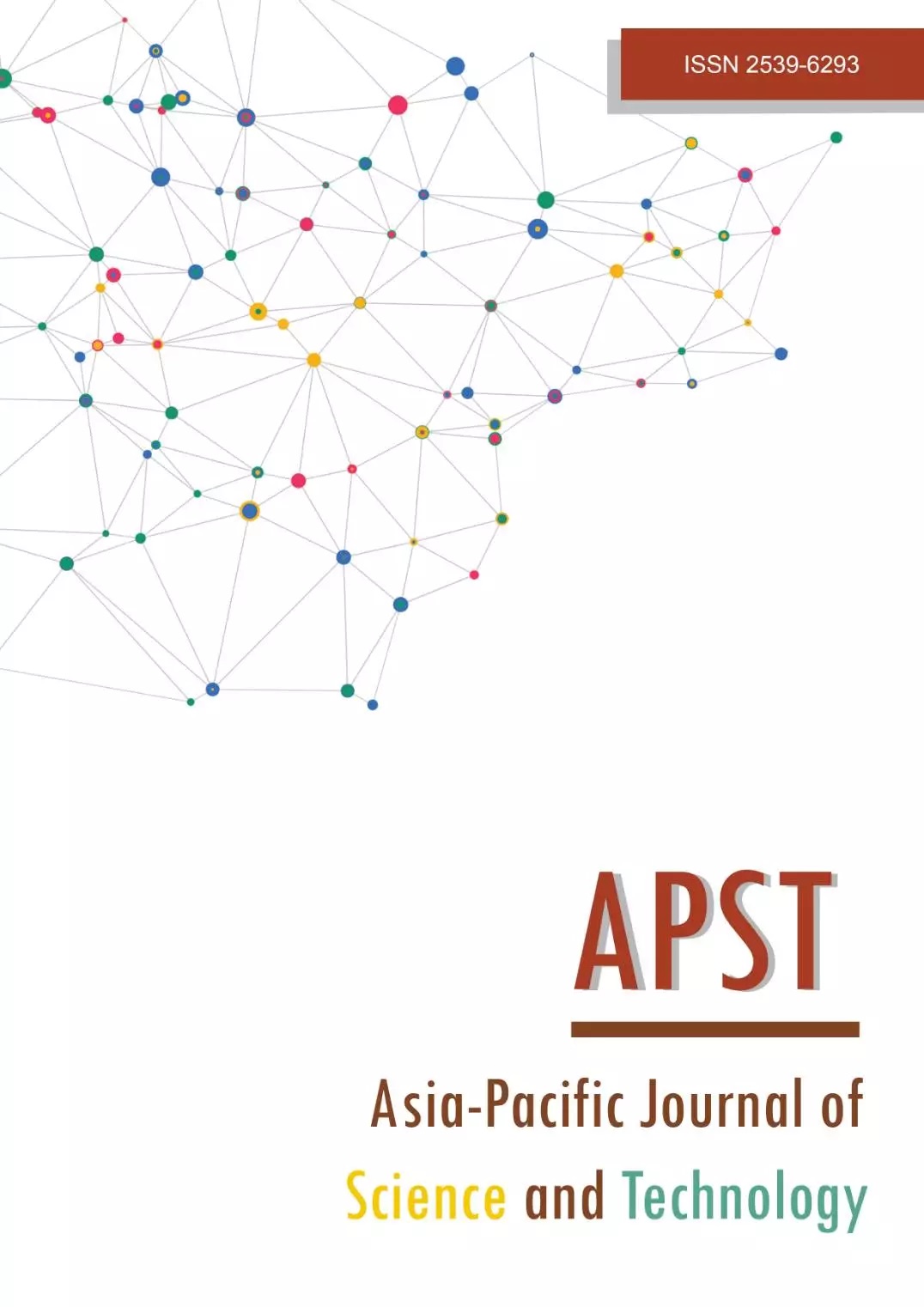Effects of an electromagnetic field on cassava root growth (cv. Rayong 72) under greenhouse conditions
Main Article Content
Abstract
An electromagnetic field is electrical energy that occurs in nature. There exist free charges that influence the evolutionary process of living, which have created a safe and new alternative way to develop crop production. This investigation aimed to study the optimal management of time and resources of an electromagnetic field for cassava root development (cv. Rayong 72). Our experiment was conducted in 4x3 factorial arrangements, in a completely randomized design (CRD), with four replications. The two experimental variables were: 1) four simulation times; 0, 15, 30, and 45 minutes; and 2) three levels of electromagnetic field intensity; 30, 40, and 50 milli Tesla (mT). The root physiology; total root length, total root surface area, root length/volume, root volume, number of root tips, root average diameter, root width, and root surface area were measured to test the effect of each electromagnetic field at 30 days after planting (DAP) under greenhouse conditions. The results showed that the interaction between time (45 minutes) and electromagnetic field intensity (30, 40, and 50 mT) produced the highest total root length, total root surface area, root length/volume, root volume, number of root tips, root diameter, root width, and surface area in Rayong 72 cassava. Additionally, changes in total root length correlated with the total root surface area (r = +0.7295**), root length per volume (r = +0.6509**), root volume (r = +0.6539**), number of root tips (r = +0.6919**), root diameter (+0.3149*), root width (r = +0.1197), and root surface area (r = +0.7130**); whereas a negative correlation existed between root length and increased volume (*Significantly different at p < 0.05, **Significantly different at p > 0.01). The increased diameter directly affected root width (r = -0.1000), resulting in decreased root width (r = -0.0360).
Article Details

This work is licensed under a Creative Commons Attribution-NonCommercial-NoDerivatives 4.0 International License.
References
Office of Agricultural Economics. Agricultural production information [Internet]. 2020 [cited 2021 May 16]. Available from: http://oae.go.th/.
Department of Business Development. Top 5 agricultural products and food exporters in Thailand [Internet]. 2020 [cited 2021 April 8]. Available from https://www.onlinenewstime.com/top-5 onlinenewstime-data/.
Howeler RH, Lutaladio N, Thomas G. Save and grow: Cassava, a guide to sustainable production intensification [Internet]. 2013 [cited 2021 April 8]. Available from http://www.fao.org/3/a-i3278e.pdf.
Rezaei-Zarchi S, Imani S, Mehrjerdi HA, Mohebbifar MR. The effect of electric field on the germination and growth of Medicaga sativa planet, as a native Iranian alfalfa seed. Acta Agriculturae Serbica. 2012;17:105-115.
Ling Y, Hai-long S. Effect of electrostatic field on seed germination and seedling growth of Sorbus pohuashanesis. J Forest Res. 2011;22(1):27-34.
Martinez E, Carbonell MV, Amaya JM. A static magnetic field of 125mT stimulates the initial growth stages of barley (Hordeum vulgare L.). Electro Magnetobiol. 2000;19(3):271-277.
Maffei EM. Magnetic field effects on plant growth, development, and evolution. Front Plant Sci. 2014;5(445):1-15.
Intanee A, Chanpradit J, Sukrakanchana N, Knongpukdee S. Effects of electric field intensity, duration, and the electric field direction on the germination and growth of tomato (Lycopersicon esculentum Kill.). Proceeding of the 29th National Conference; 2019 May 9-10; Thaksin University, Thailand. Songkhla: Thaksin University; 2019. p. 911-918. (In Thai)
Florez M, Carbonell MV, Martinez E. Exposure of maize seeds to stationary magnetic fields: Effects on germination and early growth. Environ Exp Bot. 2007;59:68-75.
Li A. Effect of gradient magnetic field on growth of stem pearls of Dioscorea opposita during seedling stage. Zhongguo Zhong Yao Za Zhi. 2000;25:341-343.
Rochalska M. The influence of low frequency magnetic field upon cultivable plant physiology. Nukleonika. 2008;53:S17-20.
Vashisth A, Nagarajan S. Exposure of seeds to static magnetic field enhance germination and early growth characteristics in chickpea (Cicer arietinum L.). Bioelectromagnetics. 2008;29:571-578.
Vashisth A, Nagarajan S. Effect on germination and early growth characteristics in sunflower (Helianthus annuus) seeds exposed to a static magnetic field. J Plant Physiol. 2010;167:149-156.
Dujpen T, Sa-ngiamvibool W. The measurement technique of surface tension using inductance values. Przeglad Elektrotechniczny. 2018;4:118-121.
Garcia F, Arze LI. Influence of a stationary magnetic field on water relations in Lettuce seeds, Part I: Theoretical considerations. Bioelectromagnetics. 2001;22:589-595.
Tataranni G, Sofo A, Casucci C, Scopa A. Different root growth patterns of tomato seedlings grown hydroponically under an electric field. Plant Root. 2013;7:28-32.
Shorstkii IA, Zherlicin AG, Li P. Impact of pulsed electric field and pulsed microwave treatment on morphological and structural characteristics of sunflower seed. OCL. 2019;26:1-7
Payez A, Ghanati F, Behmanesh M, Abdolmaleki P, Hajnorouzi A, Rajabbeigi E. Increase of seed germination, growth, and membrane integrity of wheat seedlings by exposure to static and a 10-kHz electromagnetic field. Electromagn Biol Med. 2013;32(4):417-429.
Galland P, Pazur A. Magnetoreception in plants. J Plant Res. 2005;118:371-389.
Scaiano J, Cozens FL, McLean J. Model for the rationalization of magnetic field effects in vivo. Application of the radical-pair mechanism to biological systems. Photochem Photobiol. 1994;59(6):585-589.
Yaycili O, Alikamanoglu S. The effect of magnetic field on Paulownia tissue cultures. Plant Cell Tiss Organ Cult. 2005;83:109-114.


